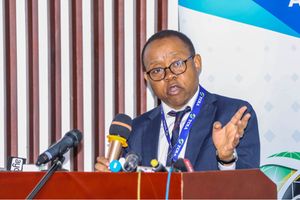Reminiscing on the arrival of the UN Rwanda Tribunal in Arusha

It was sometimes in the second half of 1994 when I received a group of about ten eminent judicial and diplomatic officers in Arusha, led by the prominent Senegalese Judge, the late Laity Kama. They flew in from New York.
The delegation had been sent by the United Nations Security Council to assess the facilities in Arusha to host the then mooted UN International Criminal Tribunal for Rwanda.
The Tribunal would be tasked with bringing to justice all those who played a role in the commission of crimes of genocide, crimes against humanity and war crimes in the territory of Rwanda, or in neighbouring territories by Rwandans, in the year 1994.
Almost a million Rwandans, mostly Tutsis and moderate Hutus, were killed between April and July in that year in Rwanda.
By then I was incharge of Conferences and Marketing at the Arusha International Conference Centre (AICC). Naturally this development was important to the Centre’s business and international marketing outreach efforts.
I showed the delegates the many facilities at the Centre; the hotels and accommodation facilities in and around Arusha; and the then newly built and modern PPF Njiro Residential Estate. I also made arrangements for the delegates to visit medical facilities in Arusha and the KCMC hospital in Moshi.
Also in the list was a visit to sporting facilities in Arusha including the Golf Course and Lawn Tennis courts at the Gymphana Club and the Squash Racket Courts at the AICC Kijenge Club and PPF Estate. A brief visit to international education facilities in Arusha and Moshi was also made, not forgetting to the many reputable culinary establishments in the city.
Then it was off to the famous tourist attractions in the northern zone, namely Mt Kilimanjaro - visited the Marangu gate, Tarangire, Lake Manyara, Ngorongoro and Serengeti parks.
All these arrangements were made to promote Arusha as an appropriate city to host this important international undertaking. And to also impress upon the delegates that the staff of the Tribunal, from all corners of the world, will be able to live and work comfortably and in a stress-free environment in Arusha.
Obviously it was the visit to the tourist parks which stunned most the visitors. The large herds of elephants in Tarangire; the shimmering parade of thousands of pink flamingoes in Lake Manyara; and the thousands of wildebeest, zebra, giraffe, antelope, to mention just a few, were impressive.
The many lions, buffaloes, hippos, hyenas, wilddogs and many other large and small animals roaming the parks’ plains also paraded before the delegates.
Actually at the Ngorongoro Crater Lodge, perched on the rim of the crater, a herd of about ten buffaloes even delayed our departure after they assembled, resting on the veranda of one charlet housing two delegates. It took the gentle ‘persuation’ of the Lodge staff to ‘convince’ the buffaloes to leave the veranda before the members could come out.
The serene and beautiful savanna plains of the Serengeti and the millions of migrating wildebeest and the attendant predators - lions, cheetahs, leopards, wilddogs, hyenas and many others - were quite a spectacle, a unique scene and an appropriate icing to the cake.
The stunning architectural marvels artistically embracing the rock formations at Seronera and Libo Wildlife Lodges were breathtaking and awesome. “What a paradise” is all that the delegates could say.
No wonder a few months later the UN showed its readiness to pick Arusha to host the ICTR. But it needed the Government of the United Republic of Tanzania to indicate its readiness to host it.
It was at this juncture that I rushed to Dar es Salaam, and with the assistance of the Legal Department of the Ministry of Foreign Affairs, rushed through a cabinet paper recommending the government approval of this mission before the deadline date set by the UN.
And on November 8, 1994, the UN Security Council passed Resolution 922 formally establishing the Tribunal, and a few months later picked Arusha to host the mission.
And as they say the rest is history. Indeed, Arusha and Tanzania added a new feather to the cap on the positive role it played diplomatically and internationally in promoting peace and security in the region.
________________________________________________________________
The author is a veteran journalist and communication expert based in Arusha.





